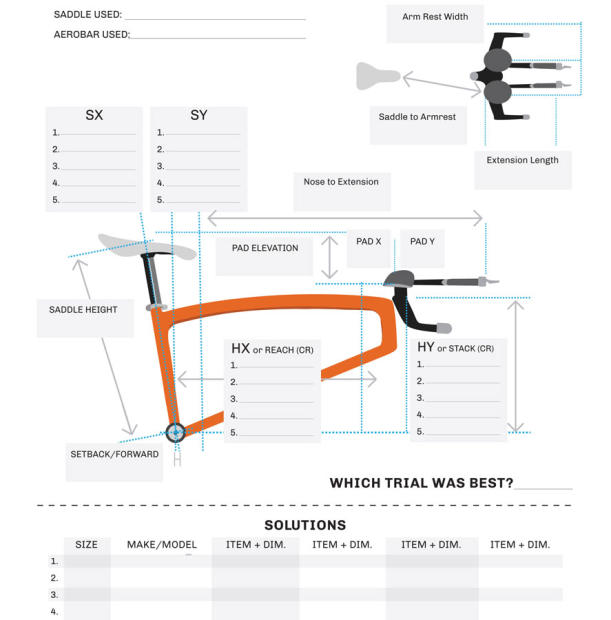RPM2 Measurement Insoles
One of my favorite parts of the endurance sports industry is meeting entrepreneurs that set out with an idea and a serious work ethic – and turn it into something that rocks our collective world. The product can be something simple, such as a Bar Fly computer mount or a Dark Speed Works canvas bag. It can be something big that changes the competitive landscape of cycling power measurement, such as Quarq or the Stages power meter.
The subject of today’s article, in my estimate, has a ton of potential. It’s called Remote Performance Measurement/Monitoring, or RPM2 for short (say “RPM squared”). RPM2 sits under the umbrella of a medical device company, called MedHab. Based in Texas, they boast US-manufacturing and offices.
The basic idea of the product is this: Put four force measuring sensors and an accelerometer inside of a shoe insole and start gathering data. Transmit that data wirelessly to an iPhone or Android smartphone. Use this tool to learn information about the athlete’s range of motion, cadence, stride distance, and other metrics. You can compare left-to-right, in search of what we all want – bilateral symmetry and reduction in sports injuries. The footbeds are simply the point of measurement; the smartphone App is your key to a wonderland of data analysis. New features and display options can be added in over time as consumer demand dictates.

RPM2 is the brainchild of a Texas man named Johnny Ross. Before starting Medhab and RPM2, Ross spent fifteen years working for Johnson & Johnson in multiple roles. I was introduced to RPM2 by Ross’ Retail Market Manager, Keith Hill, who has over twenty years of experience in kinesiology, hospital systems, and working for Stairmaster. I met both Keith and Johnny during a business trip that they took to Colorado, and had them at my disposal for an entire afternoon to demo their system and ask (many) questions.
At first blush, their history was eerily reminiscent of my first meeting with Stages Cycling, which was started by a handful of guys that worked together at Schwinn and Nautilus. There must be a certain type of mind that’s interested in fitness equipment and medical devices. Whatever it is – both companies immediately struck me as open, motivated to improve, and very hungry grow their businesses.
This article will serve as an introduction of the product, features, and my limited interaction with it so far. In the coming months, we will follow up with an in-depth piece, after I spend more time living and playing with RPM2.
Product and Features
As you can see in the photo below, RPM2 looks just like a normal insole. They recommend that most people remove the existing insoles from their shoes and replace them with RPM2, but you do have the option of leaving your normal insoles in if you wish (doubling up on insoles will reduce the volume left inside the shoe). The device comes in six sizes ranging and must be cut down to fit inside of your shoe. The size range covers women’s 3 through men’s 15.

RPM2 says that you may use the device every day if you wish, but its real intent is for periodic testing and evaluation. How often should you use it? The baseline recommendation for most people is once per week. With that amount of regular use, they quote that the system will last for two years, depending on the weight of the user and duration of each session.
There are two models of RPM2, which determine the amount of features you get. The standard model costs $599 and is meant for running and other land-based sports, such as golf, tennis, and basketball. The ‘Triathlete’ model sells for $649, and includes everything that the standard model does – plus additional cycling features.
RPM2 also sells a ‘dummy’ version of the insole sans electronics for $30, for those that want to use the same insole for all of their activities.
Training Options
There are three main ways to use RPM2 – standing pressure, pre-set exercises, and finally dynamic movements. Let’s look at the pre-set exercises first.

These exercises are meant to measure range of motion for specific movements. For example, let’s take a look at knee extension. If you’re not familiar with each motion, RPM2 provides a series of YouTube videos which you can watch from your computer, or directly from your phone:
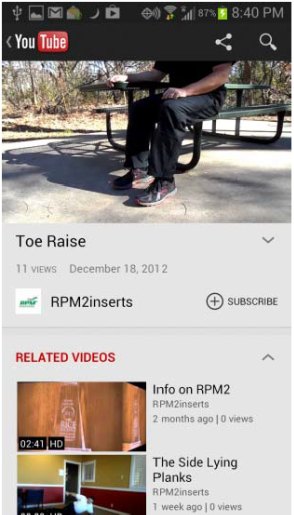
The system guides you through the processes, telling you what to do. For knee extension, you’ll sit with your legs hanging and press ‘start’. The timer starts and counts to five, then tells you to lift your leg and hold for five more seconds. Finally, you drop your leg down into the resting position. Repeat with the other leg, and your output looks like this:
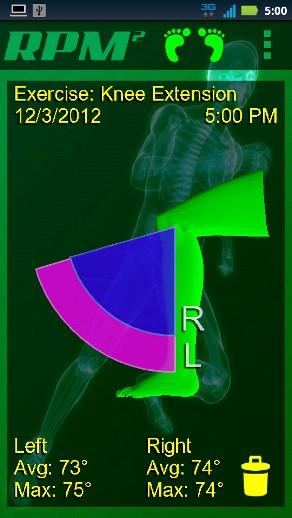
The time you hold and the number of reps you must do depends on the exercise. Hip extension looks like this:
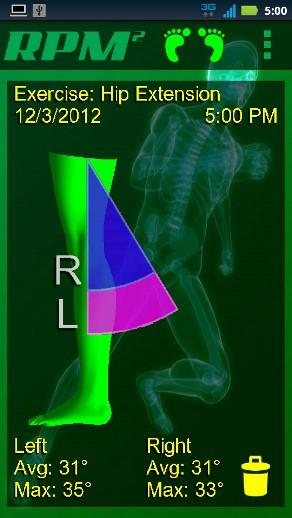
The half squat tells you the pressure exerted on each ‘quadrant’ of your foot, measured by the four pressure sensors. The output gives percentage, so you’re comparing your feet relative to each other (both feet add up to 100 percent).
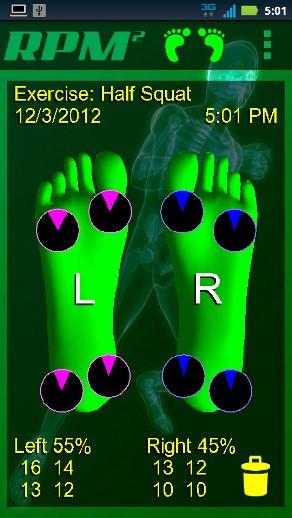
As mentioned above, there is also a simple ‘standing’ mode. For this option, all you do is press ‘start’ and stand still for one minute. The output tells you the average weight distribution for each quadrant of both feet, similar to the Half Squat above.
The final main mode for RPM2 is dynamic movement. For the standard model, that includes a 100 meter dash, or a longer run up to 4 hours. The long run option takes five random 10-second samples during your run, telling you the average step time and cadence for each segment:

The cycling option operates similar to running, allowing for a six hour ride time, and taking five random samples. The output gives you pressure in the four quadrants of each foot:
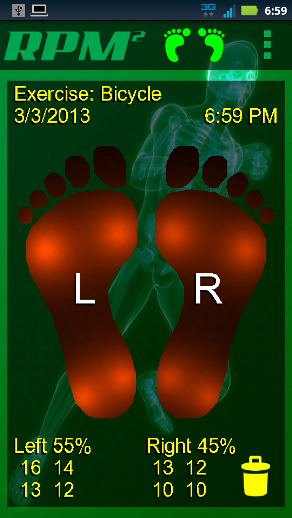
While I’ve only used the system once so far, it seemed to be very straightforward. Some of the output was shocking to me. Either the system was completely inaccurate, or I’m not as symmetrical as I thought I was. We’ll detail more about accuracy and the system’s calibration process in our in-depth review, but for now I have no reason to think that the system is not accurate.
There is a white paper on RPM2 (available on their website), which was written by Dr. Kelly Brooks of Texas A&M. The paper was published in the Journal of Sport and Human Performance, which they tell me is a 'peer-reviewed, open-access biomedical journal'. The paper does not include data sets or charts, but says that no significant differences were found in range of motion and gait analysis between the RPM2 and lab-grade equipment.
For full product instructions, RPM2 provides a detailed PDF on their website:
https://rpm2.com/How%20to%20use%20the%20App.pdf
What do you do with the data?
The question I had for Johnny and Keith was this: What the heck do I do with the data it provides? They were clear with me – RPM2 is like a power meter; it can only provide data. What you do with it is up to you and your coach, doctor, physical therapist, or other qualified expert.
I almost see this system as a Retul system for running and general movement. If one hip works differently than the other, it will tell you. If the system catches on and can meet demand, I don’t see why a Retul-equipped fit shop couldn’t carry a size run of RPM2 and add it as a supplement to the bike fit process.
Regardless of what you want to do with the data or who you want to share it with, RPM2 does make that sharing easy. You have the option to auto-email a PDF report of your exercises to two people, as seen on the menu screen:
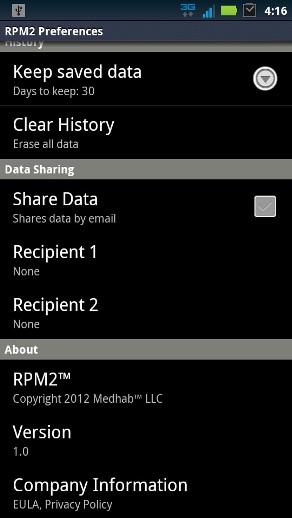
Accessories and Batteries
One piece of RPM2 that should be obvious is that you must carry your smartphone with you. They were not able to quote an exact range for me, but said it is ‘several meters’ and long enough to ensure no data drops. You can put your phone in your pocket or in an arm strap, such as this one sold by RPM2:
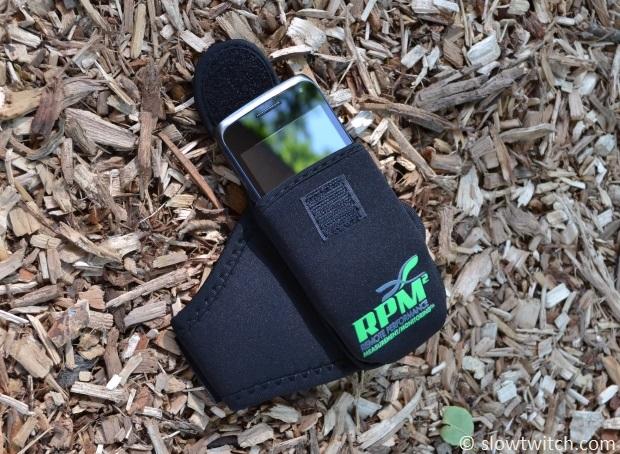
Each pair of insoles has a unique ID code, and can only be paired with one smartphone at a time.
Each footbed battery is said to last longer than the longest measurable session, which is a 6-hour bike ride. I’ll be curious to test this long-term, to see what the practical limit is, and how much it drains the phone’s battery. The main screen has an active battery life indicator, showing how much juice is left in your insoles. Charging must be done with the included wireless pad:

You must charge the insoles separately (left and right), which takes 45 minutes apiece.
Release Date and Pricing Details
The official release date for RPM2 is September 1st, 2013. Note that the initial version is only for Android phones, as the iPhone software is still in the approval process with Apple. RPM2 quoted me an expected iPhone release date of October 1st, but that they’re hoping for sooner.
Note that there is a fee for use of the App, called a Monthly Monitoring Fee. The retail price for this is $20 per month for a month-to-month basis. RPM2 is offering reduced pricing for the initial product introduction, seen here:
RPM2 – $599
RPM2 Triathlete – $649
Monthly Monitoring Fee (purchased Sept 1 – Nov 30): $10/month for the first 12 months
Monthly Monitoring Fee (purchased Dec 1 – Feb 28): $15/month for the first 12 months
Monthly Monitoring Fee: $20/month or $180 for 12 months at any time
Why not just hike the price of the system up-front and include unlimited use of the App? I asked this question to RPM2, as the monthly fee struck me as a little bit of a cheap shot for an expensive product. They responded that this was an area of heated debate, as their company got off the ground and needed to have viable long-term health (they are a privately held firm with several investors). Ross stressed that they wanted to remain competitive in price and still make a reasonable profit, but that they’re also trying to fit into the healthcare model, where the device may only be billable to insurance companies for a set period of time during a patient’s rehabilitation process. The business model needed to be such that the MSRP of the device remained as low as possible, but longer-term use could still be billable. It’s interesting, and I’ll be curious to see where it ends up.
I’d also like to see what other possibilities lay ahead. Depending on the data sampling rate of the pressure sensors and accelerometer, I have to think that there are a lot of new features that could be built in. Could this device measure power output for cycling? Could it tell me how much I ‘toe in’ or ‘toe out’ during the gait cycle? Could it measure the amount that I pull up, down, forward, and backwards during the pedal stroke? If the raw data exists, I'd imagine it's just a matter of transforming it into usable output on the phone screen.





